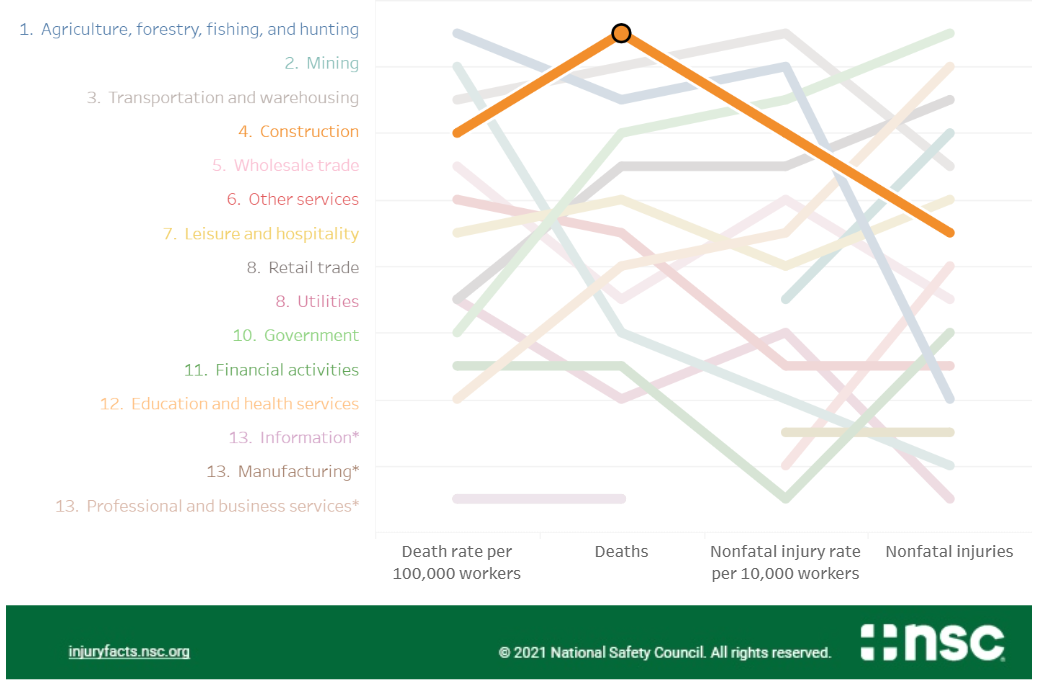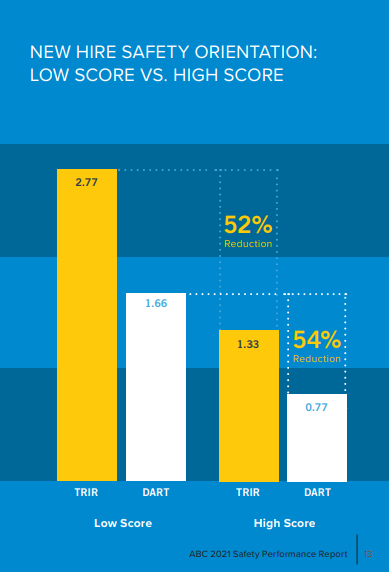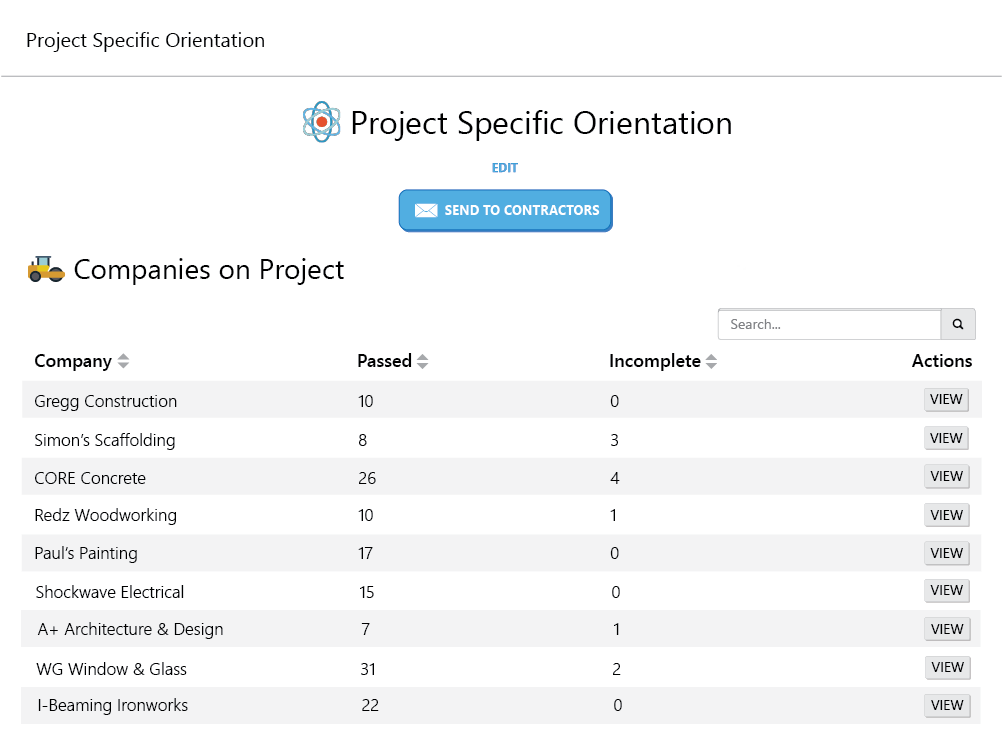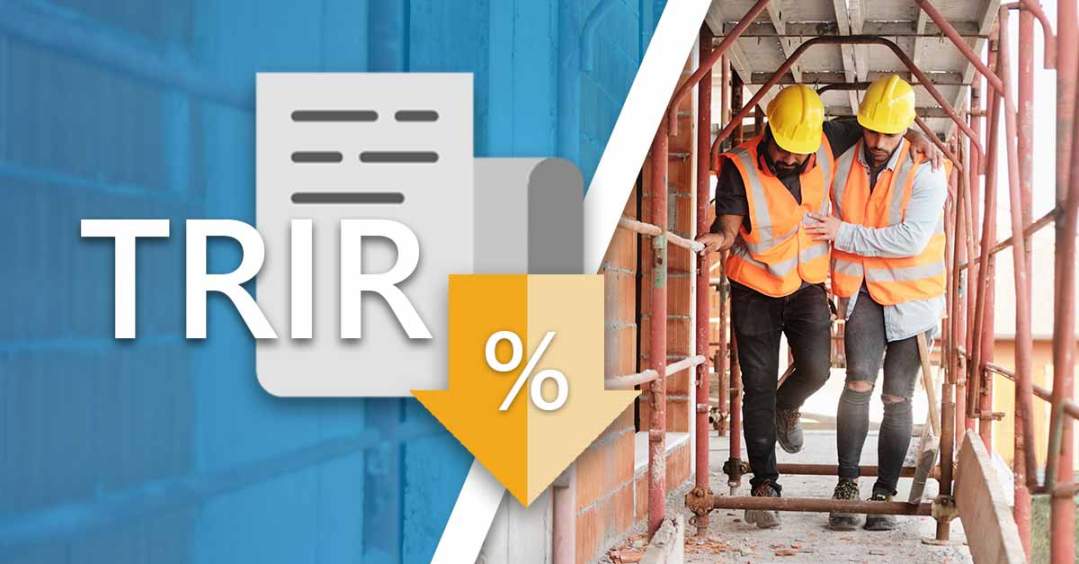Construction sites are one of the most dangerous work environments in the world. In fact, the construction sector costs three people their lives every single day in the United States alone. It’s because of this enhanced risk that metrics such as total recordable incident rate (TRIR) are closely monitored and used to evaluate construction firms.
Read on to find out what exactly TRIR is, why it’s such an important metric in the construction sector, how to calculate your TRIR score, as well as steps that general contractors can take to reduce their scores and improve overall site safety.
What is TRIR?
Total recordable incident rate (TRIR) is a measure of occupational health and safety based on the number of safety incidents reported against the number of workers present and the number of hours worked.
TRIR is a metric that was popularized by the Occupational Safety & Health Administration (OSHA) to compare the safety performance of companies within industries or groups. However, many companies also assess TRIR internally to benchmark their safety performance and, over time, assess their safety progress. TRIR can also be used within organizations to compare different divisions or cohorts based on their safety performance.
That being said, TRIR calculations are not relevant for all industries.
The Importance of TRIR in Construction
TRIR is predominantly used as a metric for goods-producing industries, such as natural resources, mining, construction, and manufacturing. However, TRIR can still be used in service providing sectors such as educational and health services, social assistance, transportation, utilities, information, and more.
However, this article will be focusing on TRIR rates in construction, why they’re important, and what you can do to improve construction site safety and reduce TRIR.
TRIR is an important metric for the construction sector because it is one of the most dangerous industries in the world with respect to both rates of incident as well as fatalities. In fact, construction clocks in at fourth for death rate per 100,000 workers, first for fatalities, fourth for nonfatal injuries per 10,000 workers, and seventh for total nonfatal injuries.
Here’s how construction stacks up against other sectors:

But it’s not just the risk and the cost to workers and their families that necessitate TRIR scoring in construction.
Additional reasons why you need to measure and work to improve your TRIR score include:
- General contractors and construction managers with publicly poor TRIR scores often see an uptick in inspections by OSHA officers and state regulatory bodies (ex. NYC Department of Buildings). These inspections often lead to more fines and an increased risk of stop work orders, which can be hugely detrimental to project timelines and margins.
- Insurance providers like AXA XL may also factor your TRIR score in with your experience modification rating (EMR), your days away restricted or transferred score, and other key metrics that will determine your rates and premiums.
- Prospective employees and employers alike may also be turned-off by a low TRIR score. Workers might be more inclined to pursue work with a general contractor with a stronger safety record, and asset owners may opt to employ the general contractor with the lower score, as they present less risk.
Now, let’s see how TRIR is calculated.
TRIR Calculation
According to OSHA, the formula for TRIR is as follows:
TRIR = Number of incidents x 200,000 / total number of employee hours worked in a year
A little confused? Here are some notes regarding the TRIR formula:
- The 200,000 is the product of the total hours 100 employees would work in 50 weeks based on a 40-hour work week. In other words, it’s an approximation of total hours 100 employees would work in the span of a year.
- When calculating the total number of hours worked for your employees, exclude all vacation hours and employee leave, as these were not actual hours worked. Including these numbers would skew your TRIR.
- All contract workers need to be factored into your calculations. Include their incidents as well as their hours worked for an accurate assessment.
Here is a sample TRIR calculation based on 6 incidents across 500,000 hours worked:
TRIR = 6 x 200,000 / 500,000
TRIR = 2.4
Now, you are probably wondering what makes a strong TRIR. Here are some benchmarks:
- A perfect TRIR is 0, the product of zero employee accidents/incidents.
- A good TRIR is less than 3.0, with the average TRIR in construction being
If you’ve calculated your TRIR and score above that 3.0 threshold, that means that you have some work to do.
What is a Recordable Incident?
To effectively calculate your TRIR, you need to understand what constitutes a “recordable incident.” In essence, the answer is anything that must be documented and reported to OSHA.
According to OSHA, incidents that need to be reported include:
- Anytime that an employee or worker loses consciousness
- If an incident causes a worker to take on light-duty, activity restrictions, or the need to be transferred to other work.
- If an incident causes a worker to take days away from work.
- If the injury requires medical treatment beyond what a first aid kit can address.
- If any other work-related health issue is diagnosed by a medical professional.
This list is not all encompassing. Visit OSHA’s “Injury and Illness Recordkeeping and Reporting Requirements” to see the complete OSHA Form 300 reporting requirements.
Or check out this video from Summit Safety Group to help you quickly assess whether an incident should be characterized as a first aid situation of an OSHA recordable incident.
How to Reduce TRIR in Construction
Construction projects are one serving of complex with two servings of dangerous, the perfect recipe for incidents. Fortunately, there are steps that general contractors and construction managers can take to reduce incidents and improve their TRIR scores.
1. Implement Preventative Safety Processes
Reducing TRIR in construction begins with enhancing project site safety. Safety is a large variable, so there are many levers that contractors can pull in order to influence and improve their site experience.
Associations like the Associated Builders and Contractors (ABC) use certain leading metrics to assess the safety of construction firms and grant top performers certification in their STEP program. Founded in 1989 as a safety benchmarking and improvement tool, STEP has grown into a world-class safety management system that assesses members based on 25 key components.
Some of the leading metrics assessed include:
- Near misses
- Unsafe acts
- Unsafe conditions
- Substance abuse programs, including drug and alcohol testing
- Toolbox talks
- Site safety orientations
- Management engagement levels
- Supervisor safety training
- Project pre-planning
- Emergency response and fire elimination plans
- Supervisory safety meetings
- Incident investigations and policies
- Safety resources and availability
- Task-specific safety education, and more
Programs like STEP are proven to help general contractors and construction managers to drive safety improvements. In fact, STEP certified firms experience a 85% reduction in TRIR and are proven to be 655% safer than other firms in their class.

Consider applying for STEP to begin your journey towards a stronger TRIR score.
2. Validate all Inputs
Often, one of the easiest ways to reduce your TRIR is by validating all your equation inputs, including OSHA recordable incidents, hours worked, and benchmarking against the proper North American Industry Classification System (NAICS) code.
Here is how to validate each input:
- Clarify that all incidents reported are OSHA recordable. Use the Form 300 criterion outlined above to scrutinize and evaluate each incident that you have reported over the past calendar year. This part is critical because the de-classification of one incident can mean dramatic reductions in TRIR rating for many construction companies.
- Ensure that all worker hours are being logged in your assessment, including the hours of all salaried and commissioned workers. This is a mistake that many construction companies and general contractors make and can lead to an inflated TRIR.
- Benchmark yourself against the right industry cohort by validating your NAICS code. An industry average of 5.0 versus 4.0 might mean the difference between a “safety conscious” rating and an “unsafe” rating.
3. Invest in Safety Orientations
Studies have proven that companies that invest in their site induction processes realize much lower rates of incident, corresponding with safer project sites and a dramatic reduction in TRIR score. In fact, general contractors that conduct in-depth worker indoctrination of safety culture, systems, and processes experience 52-54% lower incident rates than companies that provide basic safety orientations.

Source: ABC 2021 Safety Performance Report
Key assets in comprehensive safety orientations include:
- Expression of safety commitments as well as an in-depth clarification of expectations and responsibilities on-site.
- Hazard, injury, and emergency communication and reporting procedures.
- Demonstrations of proper usage of all protective gear, safety equipment, and machinery that will be utilized on-site.
- Assignment of a safety mentor to each worker for the duration of the orientation, so that workers can ask questions and get feedback in smaller group settings.
- Safety performances evaluations, assessments, and accurate record keeping to monitor safety performance following the site induction.
One of the best ways to enable more consistent safety orientations is by leveraging available construction technologies. myComply’s Orientations module is built into our robust compliance software for general contractors.

Source: myComply Orientations
With myComply orientations, you can:
- Create video, image, and text modules to build out your unique orientations’ programs, then administer tests with passing requirements to ensure that workers are retaining knowledge.
- Easily manage general orientations, site-specific orientations, as well as trade and technology specific orientations in one centralized dashboard.
- Create orientations in multiple languages to support local-area needs and requirements.
- Distribute some or all components of your orientations in a digital format to subcontractors.
- Track completions of your orientations modules at the worker level, and use myComply’s Projects Pro and on-site hardware integrations to deny site access or flag any workers that are entering a project site with incomplete training.
Conclusion
Construction sites are inherently dangerous environments. However, that doesn’t mean that steps cannot be taken by general contractors to improve key safety metrics and reap the benefits of reduced incidents, fewer site inspections, better insurance premiums, and more.
Just remember the three keys to improving your TRIR score:
- Implement preventative processes aimed at improving safety culture
- Validate all your key data points to ensure the accuracy of your score
- Invest in robust site safety inductions
If you are interested in taking a proactive and preventative approach to improving safety on your construction sites, reducing your incident rate, and slashing your TRIR score, then book a demo with myComply today.



